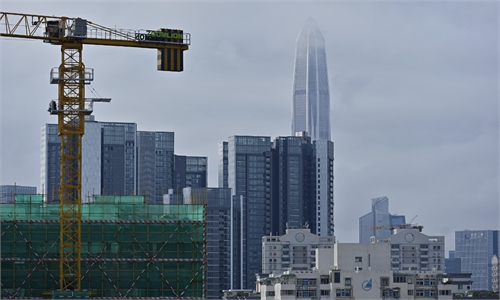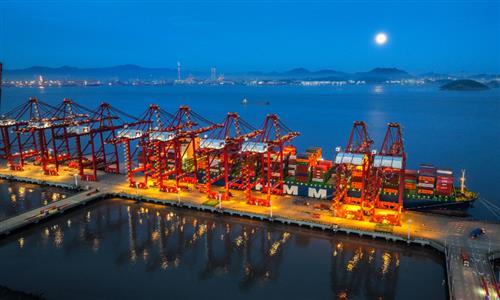Typical Western economic study misses real 'vigor' of Chinese people
A scene of the central square in Argun, on August 7, 2023. Photo: Ding Gang
"Will China, under deflation, go the way of the Soviet Union?" I laughed when I saw this title.
This title was given by Professor Xu Chenggang, a senior research scholar at the Stanford Center on China's Economic and Institutions.
Decades after China has developed from a poor and backward country to the second-largest economy in the world, many economists are still obsessed in comparing China with the Soviet Union, which makes me wonder why.
Xu made his point: the reference point for China's economy under deflation is not Japan in the 1990s but the former Soviet Union and the socialist countries of Eastern Europe. This is a typical Western economic study that only looks at the system but not the cultural and mindset changes of the people.
I came across this headline during my trip in Inner Mongolia. Just a few days ago, I took a cruise on the Argun River, the border river between China and Russia.
It was dusk. The scenery on both sides was precisely the same, the setting sun spread out on the undulating grassland, the harvested wheatland like pieces of golden plate set in green, mountains, plains, wheat fields and the river, all with changing colors into the nature's "palette."
The staggered, colorful Russian-style buildings on the China side of Shiwei, Inner Mongolia, especially the hotels with onion-shaped domes, stand in stark contrast to the outdated, low-slung houses in the village of Olochi on the Russian side.
Data shows that Zabaykalsky Krai, where Olochi is located, has a GDP per capita of roughly $4,850 (2018). In Inner Mongolia, the GDP per capita reached $10,000 in the same year. The real difference is that Inner Mongolia's GDP per capita increased nearly threefold from 2008 to 2018.
This is not my first time traveling in the Chinese-Russian border region. Before the epidemic, I had traveled or interviewed on the Russian side several times and gained some understanding of the Russian Far East bordering China.
The more significant gap is "vigor" on the Chinese side. Since its high season for tourism, Shiwei and the surrounding countryside are full of tourists. A hotel room that usually priced at more than 200 yuan ($27) rose to more than 1,000 yuan ($137). You have to queue up for more than an hour to take the cruise.
The Russian side was peaceful as usual.
The next day, when I arrived at the Olochi farm, which shares its name with the small Russian village across the river, I was even more impressed with the level of modern agriculture. Golden-colored wheat fields, lush forests, large fields of rapeseed flowers and various fruits and vegetables.
A farm employee told me that the nearby forest has been closed for 60 years, required by the state. The main income of the farm is agriculture, and the employees' annual income fluctuates according to the harvest, ranging from 50,000 to 80,000 yuan per year. Because of the climate, employees only work three to four months a year. The rest of the time, they can do other jobs.
Most of these employees own their own small yards or houses in the nearby townships, and some of them also raise some cows and sheep or have restaurants and B&Bs. Now, it is the peak season for tourism, and they can make more money.
In Enhe, the only Russian ethnic autonomous town in China, a fourth-generation Russian ethnicity farm worker told me that the town was very poor in the past, but the real change began more than 30 years ago when agriculture could make money.
According to the data, the agricultural reclamation reform in Inner Mongolia began in 1979, and the fourth wave is currently being promoted. The goal is to collectivize the reclamation area, commercialize farms and pastures, and establish large-scale, professional group enterprise companies.
In recent years, roads have been built deep into the grasslands, and railways have connected cities. For grazing, you can use the BeiDou Navigation System to navigate the flock of sheep. If a snowstorm comes, there is insurance to compensate the herders and assistance from all over the country.
The reform that started more than 40 years ago split the development path between China and Russia. Russia's economic system can no longer be used as a reference to China. The vigor released by the market-oriented reform further confirmed the characteristics of the Chinese path.
The word "vigor" is far from enough to describe the real local situation. It does not only mean that there are so many people, but also includes a kind of Chinese people's pursuits, a tremendous mental effort such as pursuing children's education, an increase in income and family happiness.
Some foreign scholars with little fieldwork experience in China are often caught up in the background or theories of Western economics and usually tend to overlook this spirit unleashed by China's push for market experience over the past four decades of reform and opening up.
I would suggest they take a cross-border trip and compare the real "vigor" of Chinese people and Russia.
The author is a senior editor with People's Daily, and currently a senior fellow with the Chongyang Institute for Financial Studies at Renmin University of China. dinggang@globaltimes.com.cn. Follow him on Twitter @dinggangchina



